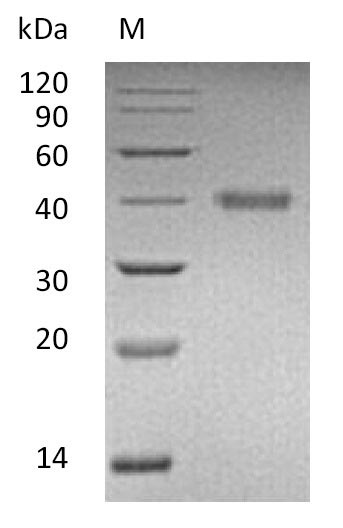Recombinant Human R-spondin-1 (RSPO1) (Active)
CAT:
399-CSB-AP005721HU-01
Size:
1 mg
Price:
Ask
- Availability: 24/48H Stock Items & 2 to 6 Weeks non Stock Items.
- Dry Ice Shipment: No




Recombinant Human R-spondin-1 (RSPO1) (Active)
- CAS Number: 9000-83-3
- Gene Name: RSPO1
- UniProt: Q2MKA7
- Expression Region: 21-263aa
- Organism: Homo sapiens
- Target Sequence: SRGIKGKRQRRISAEGSQACAKGCELCSEVNGCLKCSPKLFILLERNDIRQVGVCLPSCPPGYFDARNPDMNKCIKCKIEHCEACFSHNFCTKCKEGLYLHKGRCYPACPEGSSAANGTMECSSPAQCEMSEWSPWGPCSKKQQLCGFRRGSEERTRRVLHAPVGDHAACSDTKETRRCTVRRVPCPEGQKRRKGGQGRRENANRNLARKESKEAGAGSRRRKGQQQQQQQGTVGPLTSAGPA
- Tag: C-terminal 6xHis-tagged
- Source: Mammalian cell
- Field of Research: Developmental Biology
- Assay Type: Active Protein & In Stock Protein
- Relevance: RSPO1 is a secreted protein, containing 2 FU (furin-like) repeats and 1 TSP type-1 domain and belonging to the R-spondin family. RSPO1 is required for the early development of gonads, regardless of sex. It has been found in mice only eleven days after fertilization. To induce cell proliferation, it acts synergistically with WNT4. They help stabilize β catenin, which activates downstream targets. RSPO1 is necessary in female sex development. It augments the WNT/β catenin pathway to oppose male sex development. In critical gonadal stages, between six and nine weeks after fertilization, the ovaries upregulate it while the testes downregulate it. RSPO1 can potentially aid in the treatment of mucositis, which is characterized by inflammation of the oral cavity. This unfortunate condition often accompanies chemotherapy and radiation in cancer patients with head and neck tumors.
- Endotoxin: Less than 1.0 EU/µg as determined by LAL method.
- Purity: Greater than 95% as determined by SDS-PAGE.
- Activity: Yes
- Bioactivity: The ED50 as determined by its ability to induce Topflash reporter activity in HEK293T human embryonic kidney cells is 1-10ng/ml.
- Length: Full Length of Mature Protein
- Form: Lyophilized powder
- Buffer: Lyophilized from a 0.2 μm filtered 1xPBS, pH 7.4
- Reconstitution: We recommend that this vial be briefly centrifuged prior to opening to bring the contents to the bottom. Please reconstitute protein in deionized sterile water to a concentration of 0.1-1.0 mg/mL.We recommend to add 5-50% of glycerol (final concentration) and aliquot for long-term storage at -20℃/-80℃. Our default final concentration of glycerol is 50%. Customers could use it as reference.
- Function: Activator of the canonical Wnt signaling pathway by acting as a ligand for LGR4-6 receptors. Upon binding to LGR4-6 (LGR4, LGR5 or LGR6), LGR4-6 associate with phosphorylated LRP6 and frizzled receptors that are activated by extracellular Wnt receptors, triggering the canonical Wnt signaling pathway to increase expression of target genes. Also regulates the canonical Wnt/beta-catenin-dependent pathway and non-canonical Wnt signaling by acting as an inhibitor of ZNRF3, an important regulator of the Wnt signaling pathway. Acts as a ligand for frizzled FZD8 and LRP6. May negatively regulate the TGF-beta pathway. Has a essential roles in ovary determination. Regulates Wnt signaling by antagonizing DKK1/KREM1-mediated internalization of LRP6 through an interaction with KREM1
- Molecular Weight: 27.8 kDa
- Storage Conditions: The shelf life is related to many factors, storage state, buffer ingredients, storage temperature and the stability of the protein itself. Generally, the shelf life of liquid form is 6 months at -20℃/-80℃. The shelf life of lyophilized form is 12 months at -20℃/-80℃.
